Hidden away in southern Ky is this island of
biodiversity called Flat Rock Glade, which contains
the typical deciduous trees that you'd find
anywhere in this region.
But what's different about this island is that there are some "bald" areas called glades, which are treeless areas of exposed limestone rock.
In pockets like this,
where there is little to no soil, you can find some plants
that have adaptations for a dry, nutrient poor substrate.
This system of glades is a State Nature Preserve and protected
by the KY State Nature Preserves Commission.
It is a restricted area for research only!
(As a WKU student in the late 1980s I did a photo-essay of this glade system with Dr. Nicely
and at that time got permission to take photos only and I did so until Sept of 2016.)
Take a virtual hike with me to see some of the plants, animals,
and fungi that can be found on these glades.
If I have misidentified any species, please correct me by e-mailing the correct name to me,
and I will immediately change the name. My Profile contains my email address. Thanks!)
Let's begin our hike with a mystery that had to be solved.
For years Dr. Nicely and I wondered what could have
created these areas of turned soil. Deer? Turkey?
 |
| It looks like someone took a shovel and carefully turned the soil over. What could be doing this? What is your guess? The answer will be revealed later in this post. |
Click here to see a video of one of the many glades
that can be found here. You can get a
glimpse of the glade and hear a variety of sounds.
Flat Rock Glade has the most interesting wildflowers!
Each species has adaptations for living in the thin layer of soil around the limestone outcrop.
 |
| Shooting Star |
 |
| Named for its resemblance to a meteor shooting across the sky. Click any photo to enlarge it! |
 |
| False Garlic grows all over the glade. Click here for Info |
 |
| Yellow Stargrass Click here for Info |
 |
| Violet Wood Sorrel Click here for Info |
 |
| Widow's Cross (Sedum pulchellum) The leaves have pores that open at night and close during the heat of the day which conserves much needed water. |
 | |
| Close-up of Widow's Cross with a pollinator. |
 |
| Stemless Evening Primrose The leaves and flower arise from an underground stem. Its flower opens at dusk timed with its nocturnal pollinators. |
 |
| This glade has a thin layer of soil, allowing small forbs to grow, but not large plants, such as shrubs or trees. |
Not all plants produce seeds!
These seedless plants (liverworts and ferns) reproduce
using spores, and do not make flowers nor cones;
they produce sporangia, instead, which make the spores.
using spores, and do not make flowers nor cones;
they produce sporangia, instead, which make the spores.
The plants, below, called liverworts grow well on a glade with a very thin layer of soil like the one in the photo, above.
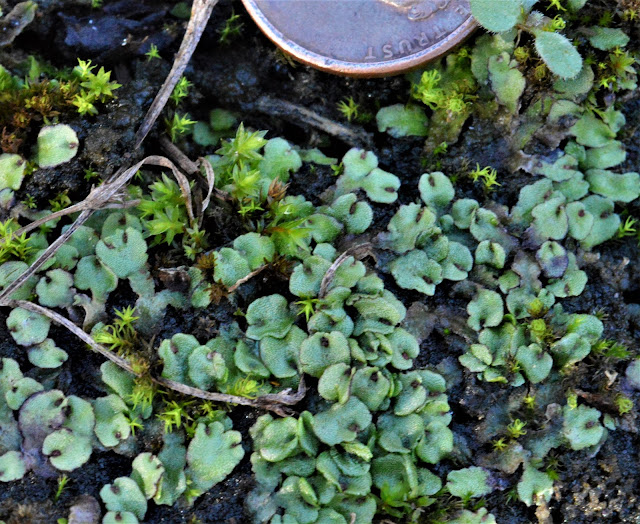 |
| Extremely Small Liverworts |
 |
| The sporophytes, which produce spores, are protruding from the green reproductive umbrella-like structures. |
 |
| Extremely tiny thalli (leaf-like structures). |
Above is an archegoniophore (helmet on a stalk), the liverwort's
reproductive structure. The light-colored sporangia are protruding
downward; they have already released their spores.
|
Ferns are also seedless plants. Here are some species
of ferns that grow on the thin layers of soil at Flat Rock.
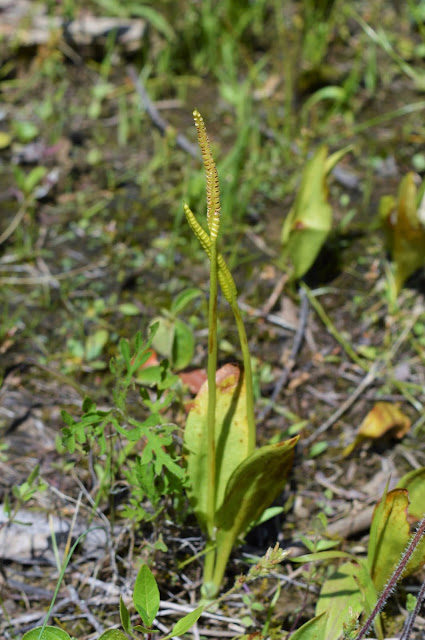 |
| Engelmannii's Fern You can see the sporophylls (sporangia) at the top of the stalks. Ferns do not produce flowers/seeds. |
 |
| The penny on the left gives you an idea of the size of this species. A typical Engelmannii's Fern has one wide frond (leaf) and one sporangium, aka a sporophyll, which produces the spores. |
Fern Fiddleheads  |
A typical fern fiddlehead...Woodsia species.
Fiddleheads are immature fern fronds (leafs) that are coiled and unfurl to form the frond. |
 |
| Most of these fronds (Woodsia) are still unfurling, with their fiddleheads at the top of the fronds. |
 | ||||
| Hairy Lipferns (above and below) grow everywhere at Flat Rock Glade.
|
 |
| The plants are growing in the area around the limestone outcrop, where there is a thin layer of soil. |
 |
| Some glades, like the one above, have many patches of moss and forbs growing on a thin layer of soil. |
There are many interesting ANIMALS that make this
glade their home. Remember that animals can be
vertebrates, such as amphibians, reptiles, or mammals, or
they can be invertebrates, like insects and snails.
 |
| One of the few species of lizards that live here! |
There are many species of birds that inhabit this area.
If you want to learn more about typical birds of Kentucky
just click here .
I heard and saw a Blue-gray Gnatcatcher.
If you want to learn more about typical birds of Kentucky
just click here .
I heard and saw a Blue-gray Gnatcatcher.
 |
| Photo taken from the Cornell site. |
 |
| MYSTERY SOLVED!! I found the culprit that was turning-up the soil !!! |
 |
| An animal like this turtle can destroy this fragile ecosystem, when it searches for invertebrates in the soil! |
I heard and then saw this White-eyed Vireo.
 |
| Photo taken from the Cornell site. |
Click here for info on the vireo and listen to their song.
The animal, below, is an invertebrate called a millipede.
 |
| I couldn't believe my eyes when I saw this spider!! It's difficult for me to look at this photo! I have arachniphobia!! |
Most of the animals you'll see here are INSECTS,
like the ones in the following photos.
like the ones in the following photos.
 |
A neat looking Dragonfly.
Must be a pond nearby, because dragonfly larvae are aquatic. Both the larvae and the adult are voracious predators of other invertebrates. |
 |
| Little Wood Satyr |
 |
| This looks like a kind of assassin bug. |
 |
| Another Hackberry Butterfly (This one's on my pants). |
 |
| A very interesting looking Praying Mantis. You can pick them up; they won't hurt you. |
 |
| Moth on Hairy Lipfern. |
 |
| A Hackberry Butterfly. |
 |
| Some insects are pollinators, such as this one on the Fleabane. |
Some species of FUNGI thrive here at Flat Rock. Examples of fungi would be mushrooms, puffballs, turkey tail, rust, devil's urn, witch's butter, and this candle-like fungus that grows on moss.
 |
| On a large boulder, I saw these strange white spikes (fungi) growing out of the moss. (see next photo) |
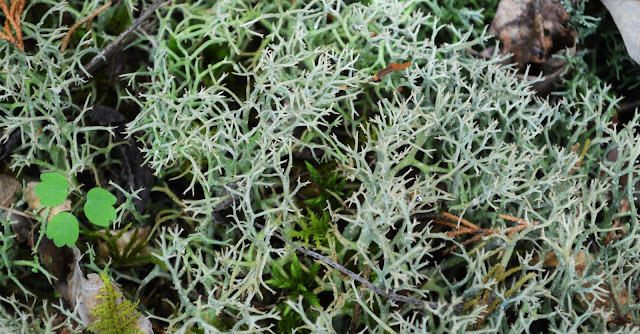 |
| Reindeer Moss, a lichen. A lichen is actually a combination of an algae and a fungus living together in a mutualistic relationship. The algae will make its own food and share it with the fungus; the fungus provides shelter, water and minerals for the algae. A perfect marriage...symbiosis! |
 |
| An otherworldly landscape!!! |
Below are more plants found at Flat Rock Glade.
The most common kind of plant that people see here will be flowering plants. Some flowers are very bright and showy, while others are very drab, but the things that make them flowers are the structures called stamen and pistils.
 |
| A shrub called Fragrant Sumac |
Click here for info about the Fragrant Sumac
 |
| Close-up of its fruit. |
 | |
|
 |
| What a beauty! |
 |
| A fly turning into a spider...on Miami Mist. (Whenever a spider eats a fly, the fly is essentially turning into the spider; the fly's atoms are used to build spider molecules.) |
Click here for info on Miami Mist
 |
| Low Hop Clover When the flower ages and dries up it resembles hop seeds. |
Click here for info on Hop Clovers
 |
| Prickly Pear Cactus with Hairy Lipferns. Some people use the pulp in the pads to make candy or syrup. |
 |
| Beautiful Prickly Pear flower. To me this is one of the most beautiful flowers around. |
 |
| Ragwort (Senecio species) |
 |
| Ruellia also called Wild Petunia |
 |
| Small Skullcap |
 |
| A spider waiting for prey to land on this Rose Pink (Sabatia angularis). |
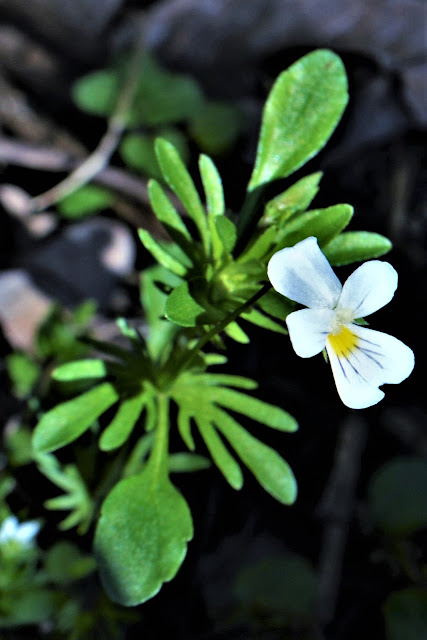 |
| A wild Field Pansy. |
 |
| Guttation occuring on the tips of the leaves of Yellow Corydalis, living in a population of giant mosses. |
 |
| St. Johnswort See the inchworm (caterpillar)? |
 | |
|
 | |
|
 |
| Narrowleaf Vervain |
Click here for info on Vervain
 |
| A beautiful Asiatic Dayflower (Commelina communis) |
 |
| Blackberry Lily, but it's neither a blackberry nor a lily! |
 |
| Sourgrass or Yellow Wood Sorrel You can eat every part of this plant...it tastes lemony, a little. |
 |
| A wild orchid called Ladies' Tress. KY has many species of orchids that grow on the ground, instead of on trees. |
 |
| The very rare Necklace Gladecress. |
 |
| The name arose when someone thought you could connect the seedpods and create a necklace. Another name is Beaded Gladecress. |
 |
| Green Dragon with its seeds. Saw three of these plants. |
 |
| Whitlow Grass (Draba verna), an extremely tiny flowering plant! You can see the seed developing even before the petals fall off!! |
 |
| A gorgeous Rue Anemone. |
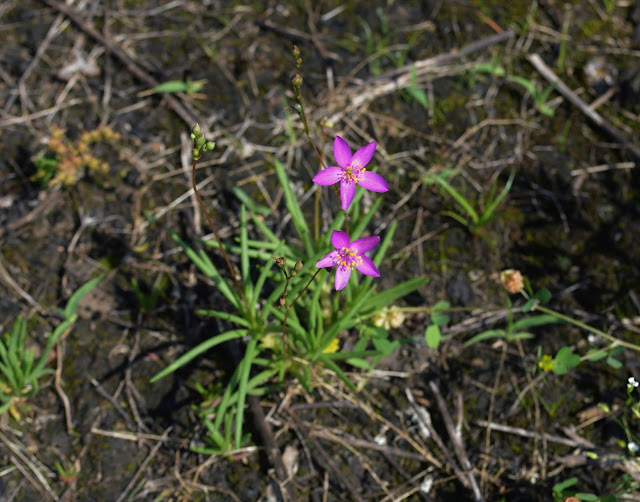 |
| A rare succulent called Fameflower (Talinum calcaricum). |
 |
What a beauty! I think the scientific name may have
been changed to Phemeranthus calcaricus. |
One winter I saw a few stems that had a florette of ice
at the base of the stems! Some of the patterns were
very beautiful! I wonder how they form!!
 |
| After a good rain you'll see areas that look like blobs of green snot. These blobs are large colonies of blue-green bacteria or Bluegreens. They are not plants nor algae!! They are bacterial colonies! This species is called Nostoc commune. This bacteria is a nitrogen fixer, taking nitrogen from the atmosphere and changing it into a compound that they and plants can use. Most bacteria are beneficial in our ecosystems, not harmful. Here's a great example. |

This limestone was formed over 400 million years ago when
this area was covered with sea water. Marine fossils, such as
 |
| These Sea Lilies, also called Crinoids, died millions of years ago and became petrified, forming these neat fossils. These animals were Echinoderms, related to the starfishes. You're looking at their stalks. (Sometimes pieces of the stalks break off and are called Indian Money.) Example of Indian Money |
Most people see glades as insignificant rock outcrops with no
economic value, but I see the ecological value of glades.
These are unusual ecosystems with some of the most interesting
species in the area. We must preserve these ecosystems so that
future generations can see the stemless evening primroses
and the fameflowers that survive despite the harsh habitat.
Please remember, this area called Flat Rock Glades Nature Preserve
is a restricted area, for research only!
I would like to thank Mrs. Perkins for her trust and generosity, for
I would like to thank Mrs. Perkins for her trust and generosity, for
allowing me to walk across her property once in awhile to get
to certain glades.





















